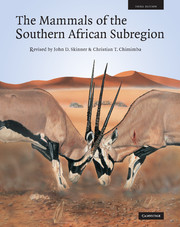Book contents
- Frontmatter
- Contents
- Editorial board
- Acknowledgements
- Foreword
- Preface
- The Mammal Research Institute
- R. H. N. Smithers
- Explanatory notes
- SUPERCOHORT AFROTHERIA
- COHORT PAENUNGULATA
- SUPERCOHORT EUARCHONTAGLIRES COHORT GLIRES
- COHORT EUARCHONTA
- SUPERCOHORT LAURASIATHERIA
- Order EULIPOTYPHLA
- Order CHIROPTERA / Bats
- COHORT FERUNGULATA
- Bibliography
- Appendix 1 Conservation status of southern African mammals
- Appendix 2 Colloquial names
- Index of scientific names
- Index of English colloquial names
- List of subscribers
- Plate Section
- Plate Section
- Plate Section
- Plate Section
- Plate Section
- Plate Section
- Plate Section
Order EULIPOTYPHLA
from SUPERCOHORT LAURASIATHERIA
Published online by Cambridge University Press: 05 July 2013
- Frontmatter
- Contents
- Editorial board
- Acknowledgements
- Foreword
- Preface
- The Mammal Research Institute
- R. H. N. Smithers
- Explanatory notes
- SUPERCOHORT AFROTHERIA
- COHORT PAENUNGULATA
- SUPERCOHORT EUARCHONTAGLIRES COHORT GLIRES
- COHORT EUARCHONTA
- SUPERCOHORT LAURASIATHERIA
- Order EULIPOTYPHLA
- Order CHIROPTERA / Bats
- COHORT FERUNGULATA
- Bibliography
- Appendix 1 Conservation status of southern African mammals
- Appendix 2 Colloquial names
- Index of scientific names
- Index of English colloquial names
- List of subscribers
- Plate Section
- Plate Section
- Plate Section
- Plate Section
- Plate Section
- Plate Section
- Plate Section
Summary
Key to the suborders (based on Meester et al., 1986)
Zygomatic arches incomplete; no more than 32 teeth (nine upper and seven lower per jaw half); upper molars with cusps in W-pattern (dilambdodont); front upper incisors strongly bilophodont, anterior cusp forming a pronounced forward-projecting hook … Soricomorpha
Zygomatic arches complete; 36 – 44 teeth … 2
Back densely covered with spines; eyes and ears normal
… Erinaceomorpha
Suborder soricomorpha
Family soricidae
G. Fischer, 1817 Shrews
Shrews are the most numerous species of Eulipotyphla in Africa. In the subregion the family is well represented by four genera and 17 species. All the African species, which belong to the subfamilies Crocidurinae and Myosoricinae, have unpigmented teeth and unique characters of the mandibular condyle, the hinge of the lower jaw, and the lower fourth premolars.
Repenning (1967) believed that shrews had their origin outside the African continent, only entering Europe in the Miocene and being first represented in Africa in the Middle Miocene, around 15 – 12 Mya, by ‘Sorex’ dehmiafricanus from Morocco. Although its dentition is primitive, there is no good evidence that this form is close to the ancestry of the many living Crocidurinae (Butler, 1978). Modern Crocidurinae and Myosoricinae differ from those of the Late Miocene and from one another by the loss of one, two or three upper and lower antemolars; a reduction in the talonid of the lower third molar; and a greater emargination of the posterior basal outline of the upper premolar and upper first molar (McLellan, 1994).
- Type
- Chapter
- Information
- The Mammals of the Southern African Sub-region , pp. 231 - 255Publisher: Cambridge University PressPrint publication year: 2005



